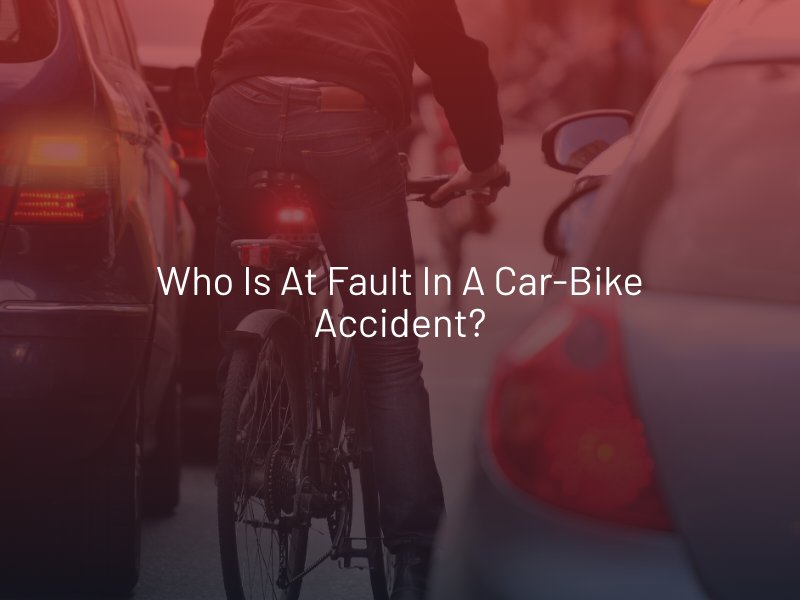Who Is at Fault in a Car-Bike Accident?
In car-bike accidents, the driver of the vehicle is typically considered to be at fault. However, our Las Vegas car accident lawyers know there are circumstances when both parties can share liability.

When the Driver is At Fault
A driver may be at fault for a bicycle accident under various circumstances, which often involve a failure to adhere to traffic laws or act in a reasonably cautious manner. For example:
- Failure to Yield Right of Way: If a driver fails to yield the right of way to a cyclist when required by traffic laws, such as a vehicle turning left into a bicyclist approaching the intersection from the opposite direction.
- Ignoring Traffic Signals and Signs: Disregarding traffic signals, stop signs, and other road signage.
- Distracted Driving: Engaging in activities like texting, talking on the phone, or using in-car entertainment systems while driving.
- Speeding: Driving above the posted speed limit or at an unsafe speed for road conditions.
- Unsafe Passing: Failing to provide sufficient space when passing a cyclist.
- Opening Car Doors Unsafely (Dooring): If a driver opens their car door without checking for oncoming cyclists, causing a collision, they are typically considered at fault.
- Failure to Use Turn Signals: Not indicating intentions to turn or change lanes.
- Impaired Driving: Operating a vehicle under the influence of alcohol, drugs, or any substance that impairs judgment and reaction time.
Determining fault in a bicycle accident is a complex process and requires a careful evaluation of all contributing factors. Eyewitness accounts, traffic camera footage, and any available evidence play a crucial role in establishing liability.
When the Bicyclist is At Fault
Bicyclists also have a duty to follow traffic laws and exercise caution. As a result, they may be found wholly or partially at fault in the following scenarios:
- Disregarding Traffic Signals and Signs: If a bicyclist ignores traffic signals, stop signs or other road signage, they can put themselves in a position where they are likely to collide with a vehicle.
- Riding Against Traffic Flow: Bicyclists are generally expected to ride in the same direction as traffic.
- Failure to Yield Right of Way: If a bicyclist fails to yield the right of way to a vehicle when required by traffic laws.
- Distracted Riding: Similar to distracted driving, if a bicyclist is engaged in activities like texting or using a phone while riding.
- Abrupt Maneuvers Without Signaling: Making sudden turns or maneuvers without signaling intentions.
- Riding at Night Without Adequate Lighting: Inadequate visibility during low light conditions or at night can increase the risk of accidents.
- Impaired Riding: Operating a bicycle under the influence of alcohol, drugs, or any substance that impairs judgment and coordination is considered negligent.
- Unsafe Passing of Vehicles: Attempting to pass a vehicle in an unsafe manner or failing to provide sufficient space for a vehicle to pass.
Third Party Liability in a Car-Bike Accident
Third-party liability in a car-bike accident refers to the legal responsibility of a party other than the cyclist or the driver involved. A ‘third party,’ for example, might be a government entity responsible for road maintenance or a manufacturer if a vehicle or bicycle defect contributed to the accident. Additionally, if a commercial vehicle was involved, the company owning the vehicle may be held liable.
Nevada’s Modified Comparative Negligence Law
Nevada’s modified comparative negligence law is a legal principle used to determine liability in accidents, including car-bike collisions. Under this law, an injured party can still seek compensation even if they are partially at fault, as long as their level of responsibility is 50% or less.
However, the amount of compensation awarded will be reduced in proportion to their degree of fault. For instance, if a bicyclist or driver is found to be 20% responsible for an accident, their compensation will be reduced by that percentage. If the cyclist’s or driver’s responsibility is 51% or more, they are generally not eligible for compensation.